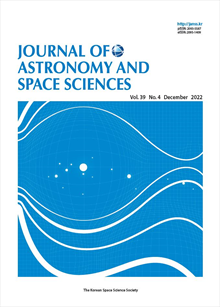간행물
Journal of Astronomy and Space Sciences KCI 등재 SCOPUS

- 발행기관 한국우주과학회
- 자료유형 학술지
- 간기 계간
- ISSN 2093-5587 (Print)2093-1409 (Online)
- 수록기간 1984 ~ 2022
- 주제분류 자연과학 > 천문학 자연과학 분류의 다른 간행물
- 십진분류KDC 443DDC 520
권호리스트/논문검색
제28권 1호 (2011년 3월) 11건
1.
2011.03
서비스 종료(열람 제한)
2.
2011.03
서비스 종료(열람 제한)
3.
2011.03
서비스 종료(열람 제한)
4.
2011.03
서비스 종료(열람 제한)
5.
2011.03
서비스 종료(열람 제한)
The present study examines the morning-afternoon asymmetry of the geosynchronous magnetic field strength on the dayside (magnetic local time [MLT] = 06:00~18:00) using observations by the Geostationary Operational Environmental Satellites (GOES) over a period of 9 years from February 1998 to January 2007. During geomagnetically quiet time (Kp < 3), we observed that a peak of the magnetic field strength is skewed toward the earlier local times (11:07~11:37 MLT) with respect to local noon and that the geosynchronous field strength is larger in the morning sector than in the afternoon sector. That is, there is the morning-afternoon asymmetry of the geosynchronous magnetic field strength. Using solar wind data, it is confirmed that the morning-afternoon asymmetry is not associated with the aberration effect due to the orbital motion of the Earth about the Sun. We found that the peak location of the magnetic field strength is shifted toward the earlier local times as the ratio of the magnetic field strength at MLT = 18 (B-dusk) to the magnetic field strength at MLT = 06 (B-dawn) is decreasing. It is also found that the dawn-dusk magnetic field median ratio, B-dusk/B-dawn, is decreasing as the solar wind dynamic pressure is increasing. The morning-afternoon asymmetry of the magnetic field strength appears in Tsyganenko geomagnetic field model (TS-04 model) when the partial ring current is included in TS- 04 model. Unlike our observations, however, TS-04 model shows that the peak location of the magnetic field strength is shifted toward local noon as the solar wind dynamic pressure grows in magnitude. This may be due to that the symmetric magnetic field associated with the magnetopause current, strongly affected by the solar wind dynamic pressure, increases. However, the partial ring current is not affected as much as the magnetopause current by the solar wind dynamic pressure in TS-04 model. Thus, our observations suggest that the contribution of the partial ring current at geosynchronous orbit is much larger than that expected from TS-04 model as the solar wind dynamic pressure increases.
6.
2011.03
서비스 종료(열람 제한)
7.
2011.03
서비스 종료(열람 제한)
8.
2011.03
서비스 종료(열람 제한)
9.
2011.03
서비스 종료(열람 제한)
10.
2011.03
서비스 종료(열람 제한)
11.
2011.03
서비스 종료(열람 제한)
Jung Hyun Jo, In Kwan Park, Hyung-Chul Lim, Yoon-Kyoung Seo, Hong-Seo Yim, Jin-Young Lee, Seung-Cheol Bang, Jakyoung Nah, Kwang Dong Kim, Jeong Gyun Jang, Bi Ho Jang, Jang Hyun Park, Jong-Uk Park

